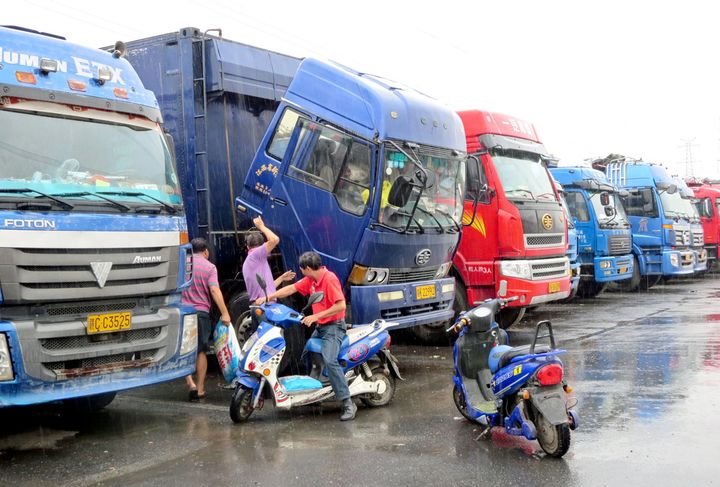Photo: Deborah Lockridge
Truck parking is a problem facing drivers around the world. Here, a truckstop outside Shanghai.
The scarcity of safe truck parking is a serious issue around the world. In fact, according to the IRU, otherwise known as the International Road Transport Union, that scarcity is a major part of the “challenging working conditions” suffered by drivers from Russia to Mexico, Europe to China. And improving those conditions – parking in particular – is seen as a key to resolving the driver shortage.
That’s right, the truck driver shortage is not a uniquely North American problem.
A broad survey done between October 2020 and January 2021 by the IRU showed that the global shortage is serious and about to get worse.
The organization was founded 70 years ago to help war-torn Europe rebuild devastated trade and commercial links. It’s now active in more than 100 countries, having long-standing partnerships with the United Nations, the European Union, and Eurasian institutions, though there’s little connection to us in North America.
Yep, I’m talking about the “driver shortage” again. I know, some of you are going to yell at me for even uttering that phrase, but it’s real. The thing is, it isn’t occurring just here. It’s a global phenomenon, generated in large part by simple demographics – existing drivers are getting older and ready to retire, but they’re not being replaced by young people.
“Despite reduced demand due to COVID-19, there is still an alarming shortage of drivers,” says the organization. “Surveying 777 road transport companies from 23 countries, the IRU found that [the] driver shortage was most acute in Eurasia, where last year 20% of driver positions were not filled. China was the least affected country in 2020 with only 4% of jobs open. Elsewhere, [the] driver shortage was less serious in 2020 than 2019 due to the pandemic. In Europe, unfilled driver positions fell by around three quarters, from 24% to 7% for truck drivers.”
But European companies are expecting a 17% shortfall in drivers this year, 18% in Mexico, 20% in Turkey, 24% in Russia, and almost one third in Uzbekistan, says the IRU.
The survey also investigated the reasons for the driver shortage, finding that a simple lack of trained drivers was the main cause in all regions (38% of respondents). It also cited those “challenging working conditions,” further exacerbated by the pandemic.
As in North America, but worse, the survey also noted difficulties attracting women and young people to the profession.
Only 2% of truck drivers globally are women, says the IRU (compared to 6% in the U.S. and 3.5% in Canada), and all countries surveyed saw the percentage of women truck drivers fall last year. That percentage was just 0.3% in Russia last year, 0.1% in China.
The Truck Driver Demographics Problem
The percentage of truck drivers under age 25 fell nearly everywhere in 2020, from already low levels down to 5% in Europe and Russia, 6% in Mexico and 7% in Turkey.
“With the average age of professional truck drivers globally now close to 50, and steadily growing older each year, this demographic time bomb will only get worse without action to reduce minimum driver age,” says the IRU.
Sound familiar? We’re getting calls for similar action here in North America, which has been getting mixed reviews at best.
With youth unemployment well over 30% in some countries, attracting young people to the sector should be simple, according to the IRU report. But the minimum age for professional drivers is 21 or higher in many places, creating a large gap between leaving school and taking the wheel.
“Governments should set the minimum age for trained drivers at 18, with training starting from 17, in order to unlock the full potential of the profession as a global job engine,” the IRU suggests.
Some trucking interests say the same in the U.S., where the federal minimum age is 21 – even though all but one state allow younger drivers to operate commercial trucks within their borders. People complain about the lack of logic in being allowed to drive from one side of Texas to the other but not from one side of town to the other in cities that cross state borders.
In April, more than 100 trucking and business organizations wrote to the House and Senate transportation committees in support of the DRIVE-Safe Act, which would allow commercial truck drivers under the age of 21 to cross states lines after completing certain training and apprenticeship requirements. There’s a push to include it in infrastructure legislation currently being volleyed about in Washington, but there’s also pushback from safety groups.
The Commonalities of the Global Driver Shortage
“More investment in safe and secure truck parking areas to fix the current massive global shortfall would make long-haul driver conditions safer and get more people behind the wheel, especially women,” the IRU report adds.
It warms my little heart to see that the IRU report acknowledged that drivers around the world are poorly treated at delivery sites and borders due to the temporary controls required by COVID-19 restrictions, which it says had a negative impact on the attractiveness of the profession last year.
And look at this statement: Working conditions will improve when drivers are treated with more respect.
“The solutions are there, but if governments do not act now to ease access to profession, improve working conditions and upskill the workforce, the driver shortage will continue to disrupt and eventually irreparably damage vital mobility networks and supply chains,” concluded the IRU report.
Clearly, we’re not alone.
Author
Rolf Lockwood
Executive Contributing Editor
Source: https://www.truckinginfo.com/





